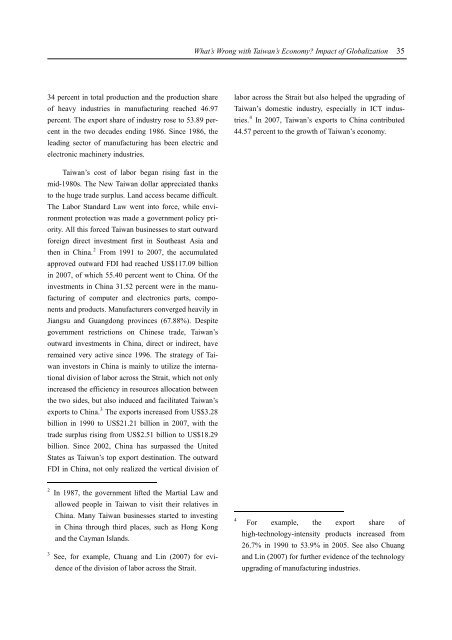PDF(2.7mb) - 國家政策研究基金會
PDF(2.7mb) - 國家政策研究基金會
PDF(2.7mb) - 國家政策研究基金會
You also want an ePaper? Increase the reach of your titles
YUMPU automatically turns print PDFs into web optimized ePapers that Google loves.
What’s Wrong with Taiwan’s Economy? Impact of Globalization 35<br />
34 percent in total production and the production share<br />
of heavy industries in manufacturing reached 46.97<br />
percent. The export share of industry rose to 53.89 percent<br />
in the two decades ending 1986. Since 1986, the<br />
leading sector of manufacturing has been electric and<br />
electronic machinery industries.<br />
labor across the Strait but also helped the upgrading of<br />
Taiwan’s domestic industry, especially in ICT industries.<br />
4 In 2007, Taiwan’s exports to China contributed<br />
44.57 percent to the growth of Taiwan’s economy.<br />
Taiwan’s cost of labor began rising fast in the<br />
mid-1980s. The New Taiwan dollar appreciated thanks<br />
to the huge trade surplus. Land access became difficult.<br />
The Labor Standard Law went into force, while environment<br />
protection was made a government policy priority.<br />
All this forced Taiwan businesses to start outward<br />
foreign direct investment first in Southeast Asia and<br />
then in China. 2 From 1991 to 2007, the accumulated<br />
approved outward FDI had reached US$117.09 billion<br />
in 2007, of which 55.40 percent went to China. Of the<br />
investments in China 31.52 percent were in the manufacturing<br />
of computer and electronics parts, components<br />
and products. Manufacturers converged heavily in<br />
Jiangsu and Guangdong provinces (67.88%). Despite<br />
government restrictions on Chinese trade, Taiwan’s<br />
outward investments in China, direct or indirect, have<br />
remained very active since 1996. The strategy of Taiwan<br />
investors in China is mainly to utilize the international<br />
division of labor across the Strait, which not only<br />
increased the efficiency in resources allocation between<br />
the two sides, but also induced and facilitated Taiwan’s<br />
exports to China. 3 The exports increased from US$3.28<br />
billion in 1990 to US$21.21 billion in 2007, with the<br />
trade surplus rising from US$2.51 billion to US$18.29<br />
billion. Since 2002, China has surpassed the United<br />
States as Taiwan’s top export destination. The outward<br />
FDI in China, not only realized the vertical division of<br />
2 In 1987, the government lifted the Martial Law and<br />
allowed people in Taiwan to visit their relatives in<br />
China. Many Taiwan businesses started to investing<br />
in China through third places, such as Hong Kong<br />
and the Cayman Islands.<br />
3 See, for example, Chuang and Lin (2007) for evidence<br />
of the division of labor across the Strait.<br />
4<br />
For example, the export share of<br />
high-technology-intensity products increased from<br />
26.7% in 1990 to 53.9% in 2005. See also Chuang<br />
and Lin (2007) for further evidence of the technology<br />
upgrading of manufacturing industries.

















